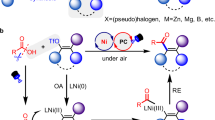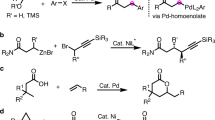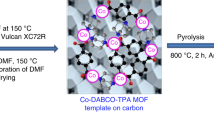Abstract
Reusable catalysts based on earth-abundant metals with a broad applicability in organic synthesis are a key to a more sustainable production of fine chemicals, pharmaceuticals and agrochemicals. Herein, we report on a nanostructured nickel catalyst for the general and selective synthesis of primary amines via reductive amination, employing ammonia dissolved in water. Our catalyst, which operates at low temperature and pressure, is highly active, reusable and easy to handle. The synthesis from a specific nickel complex and γ-Al2O3 is straightforward, with the ligand–metal combination of this complex being crucial. Aldehydes (including purely aliphatic ones), aryl–alkyl, dialkyl and diaryl ketones can all be converted smoothly into primary amines. In addition, the amination of pharmaceuticals, bioactive compounds and natural products is demonstrated. Many functional groups—including hydrogenation-sensitive examples—are tolerated. We expect that our findings will inspire others to develop reusable and nanostructured earth-abundant metal catalysts for complex organic transformations.
This is a preview of subscription content, access via your institution
Access options
Access Nature and 54 other Nature Portfolio journals
Get Nature+, our best-value online-access subscription
$29.99 / 30 days
cancel any time
Subscribe to this journal
Receive 12 digital issues and online access to articles
$119.00 per year
only $9.92 per issue
Buy this article
- Purchase on Springer Link
- Instant access to full article PDF
Prices may be subject to local taxes which are calculated during checkout

Similar content being viewed by others
Data availability
All data are available from the authors upon reasonable request.
References
Boddien, A. et al. Efficient dehydrogenation of formic acid using an iron catalyst. Science 333, 1733–1736 (2011).
Tondreau, A. M. et al. Iron catalysts for selective anti-Markovnikov alkene hydrosilylation using tertiary silanes. Science 335, 567–570 (2012).
Zuo, W., Lough, A. J., Li, Y. F. & Morris, R. H. Amine(imine)diphosphine iron catalysts for asymmetric transfer hydrogenation of ketones and imines. Science 342, 1080–1083 (2013).
Friedfeld, M. R. et al. Cobalt precursors for high-throughput discovery of base metal asymmetric alkene hydrogenation catalysts. Science 342, 1076–1080 (2013).
Hoyt, J. M., Schmidt, V. A., Tondreau, A. M. & Chirik, P. J. Iron-catalyzed intermolecular [2+2] cycloadditions of unactivated alkenes. Science 349, 960–963 (2015).
Korstanje, T. J., van der Vlugt, J. I., Elsevier, C. J. & de Bruin, B. Hydrogenation of carboxylic acids with homogeneous cobalt catalyst. Science 350, 298–302 (2015).
Yu, R. P., Hesk, D., Rivera, N., Pelczer, I. & Chirik, P. J. Iron-catalysed tritiation of pharmaceuticals. Nature 529, 195–199 (2016).
Friedfeld, M. R., Zhong, H., Ruck, R. T., Shevlin, M. & Chirik, P. J. Cobalt-catalyzed hydrogenation of enamides enabled by single-electron reduction. Science 360, 888–893 (2018).
Filonenko, G. A., van Putten, R., Hensen, E. J. M. & Pidko, E. A. Catalytic (de)hydrogenation promoted by nonprecious metals—Co, Fe and Mn: recent advances in an emerging field. Chem. Soc. Rev. 47, 1459–1483 (2018).
Kallmeier, F. & Kempe, R. Manganese complexes for (de)hydrogenation catalysis: a comparison to cobalt and iron catalysts. Angew. Chem. Int. Ed. 57, 46–60 (2018).
Jagadeesh, R. V. et al. Nanoscale Fe2O3-based catalysts for selective hydrogenation of nitroarenes to anilines. Science 342, 1073–1076 (2013).
Westerhaus, F. A. et al. Heterogenized cobalt oxide catalysts for nitroarene reduction by pyrolysis of molecularly defined complexes. Nat. Chem. 5, 537–543 (2013).
Jagadeesh, R. V. et al. MOF-derived cobalt nanoparticles catalyze a general synthesis of amines. Science 358, 326–332 (2017).
Weissermel, K. & Arpe, H.-J. Industrial Organic Chemistry (Wiley-VCH, Weinheim, 2008).
Vardanyan, R. S. & Hruby, V. J. Synthesis of Best-Seller Drugs (Academic Press, Amsterdam, 2016).
Lawrence, S. A. Amines. Synthesis, Properties and Applications (Cambridge Univ. Press, Cambridge, 2004).
Gomez, S., Peters, J. A. & Maschmeyer, T. The reductive amination of aldehydes and ketones and the hydrogenation of nitriles: mechanistic aspects and selectivity control. Adv. Synth. Catal. 344, 1037–1057 (2002).
Klinkenberg, J. L. & Hartwig, J. F. Catalytic organometallic reactions of ammonia. Angew. Chem. Int. Ed. 50, 86–95 (2011).
Kim, J., Kim, H. J. & Chang, S. Synthetic uses of ammonia in transition-metal catalysis. Eur. J. Org. Chem. 2013, 3201–3213 (2013).
Alinezhad, H., Yavari, H. & Salehian, F. Recent advances in reductive amination catalysis and its applications. Curr. Org. Chem. 19, 1021–1049 (2015).
Legnani, L., Bhawal, B. & Morandi, B. Recent developments in the direct synthesis of unprotected primary amines. Synthesis 49, 776–789 (2017).
Gross, T., Seayad, A. M., Ahmad, M. & Beller, M. Synthesis of primary amines. First homogeneously catalysed reductive amination with ammonia. Org. Lett. 4, 2055–2058 (2002).
Ogo, S., Uehara, K., Abura, T. & Fukuzumi, S. pH-Dependent chemoselective synthesis of ɑ-amino acids. Reductive amination of ɑ-keto acids with ammonia catalyzed by acid-stable iridium hydride complexes in water. J. Am. Chem. Soc. 126, 3020–3021 (2004).
Gallardo-Donaire, J., Ernst, M., Trapp, O. & Schaub, T. Direct synthesis of primary amines via ruthenium-catalysed amination of ketones with ammonia and hydrogen. Adv. Synth. Catal. 358, 358–363 (2016).
Bódis, J., Lefferts, L., Müller, T. E., Pestman, R. & Lercher, J. A. Activity and selectivity control in reductive amination of butyraldehyde over noble metal catalysts. Catal. Lett. 104, 23–28 (2005).
Dong, B. et al. Heterogeneous Ru-based catalysts for one-pot synthesis of primary amines from aldehydes and ammonia. Catalysts 5, 2258–2270 (2015).
Nakamura, Y., Kon, K., Touchy, A. S., Shimizu, K.-I. & Ueda, W. Selective synthesis of primary amines by reductive amination of ketones with ammonia over supported Pt catalysts. ChemCatChem 7, 921–924 (2015).
Chatterjee, M., Ishizaka, T. & Kawanami, H. Reductive amination of furfural to furfurylamine using aqueous ammonia solution and molecular hydrogen. An environmentally friendly approach. Green Chem. 18, 487–496 (2016).
Nishimura, S., Mizuhori, K. & Ebitani, K. Reductive amination of furfural toward furfurylamine with aqueous ammonia under hydrogen over Ru-supported catalyst. Res. Chem. Intermed. 42, 19–30 (2016).
Liang, G. et al. Production of primary amines by reductive amination of biomass-derived aldehydes/ketones. Angew. Chem. Int. Ed. 56, 3050–3054 (2017).
Komanoya, T., Kinemura, T., Kita, Y., Kamata, K. & Hara, M. Electronic effect of ruthenium nanoparticles on efficient reductive amination of carbonyl compounds. J. Am. Chem. Soc. 139, 11493–11499 (2017).
Alexander, E. R. & Misegades, A. L. A low pressure reductive alkylation method for the conversion of ketones to primary amines. J. Am. Chem. Soc. 70, 1315–1316 (1948).
Klyuev, M. V. & Khidekel', M. L. Catalytic amination of alcohols, aldehydes and ketones. Russ. Chem. Rev. 49, 14–27 (1980).
Winans, C. F. Hydrogenation of aldehydes in the presence of ammonia. J. Am. Chem. Soc. 61, 3566–3567 (1939).
Chan, A. S., Chen, C.-C. & Lin, Y.-C. Catalytic reductive amination of α-ketocaboxylic acids as a useful route to amino acids. Appl. Catal. A Gen. 119, L1–L5 (1994).
Dolezal, P. et al. Reductive amination of cyclopentanone. Appl. Catal. A 286, 202–210 (2005).
Zimmermann, B., Herwig, J. & Beller, M. The first efficient hydroaminomethylation with ammonia: with dual metal catalysts and two-phase catalysis to primary amines. Angew. Chem. Int. Ed. 38, 2372–2375 (1999).
Prinz, T. & Driessen-Hölscher, B. Biphasic catalyzed telomerization of butadiene and ammonia: kinetics and new ligands for regioselective reactions. Chem. Eur. J. 5, 2069–2076 (1999).
Nagano, T. & Kobayashi, S. Palladium-catalyzed allylic amination using aqueous ammonia for the synthesis of primary amines. J. Am. Chem. Soc. 131, 4200–4201 (2009).
Das, K. et al. Platinum‐catalyzed direct amination of allylic alcohols with aqueous ammonia: selective synthesis of primary allylamines. Angew. Chem. Int. Ed. 51, 150–154 (2012).
Schranck, J. & Tlili, A. Transition-metal-catalyzed monoarylation of ammonia. ACS Catal. 8, 405–418 (2018).
Guo, B., Zhang, Q., Li, G., Yao, J. & Hu, C. Aromatic C–N bond formation via simultaneous activation of C–H and N–H bonds: direct oxyamination of benzene to aniline. Green Chem. 14, 1880–1883 (2012).
Fujita, K.-I., Furukawa, S., Morishima, N., Shimizu, M. & Yamaguchi, R. N‐alkylation of aqueous ammonia with alcohols leading to primary amines catalyzed by water‐soluble N‐heterocyclic carbene complexes of iridium. ChemCatChem 10, 1993–1997 (2018).
Rösler, S., Obenauf, J. & Kempe, R. A highly active and easily accessible cobalt catalyst for selective hydrogenation of C═O bonds. J. Am. Chem. Soc. 137, 7998–8001 (2015).
Rösler, S., Ertl, M., Irrgang, T. & Kempe, R. Cobalt-catalyzed alkylation of aromatic amines by alcohols. Angew. Chem. Int. Ed. 54, 15046–15050 (2015).
Deibl, N. & Kempe, R. General and mild cobalt-catalyzed C-alkylation of unactivated amides and esters with alcohols. J. Am. Chem. Soc. 138, 10786–10789 (2016).
Kallmeier, F., Irrgang, T., Dietel, T. & Kempe, R. Highly active and selective manganese C=O bond hydrogenation catalysts: the importance of the multidentate ligand, the ancillary ligands, and the oxidation state. Angew. Chem. Int. Ed. 55, 11806–11809 (2016).
Deibl, N. & Kempe, R. Manganese-catalyzed multicomponent synthesis of pyrimidines from alcohols and amidines. Angew. Chem. Int. Ed. 56, 1663–1666 (2017).
Kallmeier, F., Dudziec, B., Irrgang, T. & Kempe, R. Manganese-catalyzed sustainable synthesis of pyrroles from alcohols and amino alcohols. Angew. Chem. Int. Ed. 56, 7261–7265 (2017).
Zhang, G., Irrgang, T., Dietel, T., Kallmeier, F. & Kempe, R. Manganese-catalyzed dehydrogenative alkylation or ɑ-olefination of alkyl-substituted N-heteroarenes with alcohols. Angew. Chem. Int. Ed. 57, 9131–9135 (2018).
Forberg, D. et al. Single-catalyst high-weight% hydrogen storage in an N-heterocycle synthesized from lignin hydrogenolysis products and ammonia. Nat. Commun. 7, 13201 (2016).
Forberg, D., Schwob, T. & Kempe, R. Catalytic condensation for the formation of polycyclic heteroaromatic compounds. Nat. Commun. 9, 695 (2018).
Schwob, T. & Kempe, R. A reusable co catalyst for the selective hydrogenation of functionalized nitroarenes and the direct synthesis of imines and benzimidazoles from nitroarenes and aldehydes. Angew. Chem. Int. Ed. 55, 15175–15179 (2016).
Zaheer, M. & Kempe, R. Catalytic hydrogenolysis of aryl ethers. A key step in lignin valorization to valuable chemicals. ACS Catal. 5, 1675–1684 (2015).
Acknowledgements
The authors thank the Deutsche Forschungsgemeinschaft for financial support (B1, SFB 840) and E. Arzt for his support through INM. In addition, the authors thank F. Puchtler and M. Ries for PXRD, U. Lacher for HRMS, J. Thiessen for NH3-TPD, J. Schmauch for the assistance with the EELS measurements and J. Seidel, TU Bergakademie Freiberg, Institut für Physikalische Chemie, for XPS.
Author information
Authors and Affiliations
Contributions
G.H. carried out the catalyst synthesis, catalyst characterization and the catalytic reactions. P.K. and N.d.J. performed HAADF–STEM imaging coupled with EDX and EELS analysis. G.H. and R.K. designed the experiments and co-wrote the manuscript.
Corresponding author
Ethics declarations
Competing interests
The authors declare no competing interests.
Additional information
Publisher’s note: Springer Nature remains neutral with regard to jurisdictional claims in published maps and institutional affiliations.
Supplementary information
Supplementary Information
Supplementary Tables 1–6, Supplementary Notes 1–4, Supplementary Methods, Supplementary Figures 1–60, Supplementary References
Rights and permissions
About this article
Cite this article
Hahn, G., Kunnas, P., de Jonge, N. et al. General synthesis of primary amines via reductive amination employing a reusable nickel catalyst. Nat Catal 2, 71–77 (2019). https://doi.org/10.1038/s41929-018-0202-6
Received:
Accepted:
Published:
Issue Date:
DOI: https://doi.org/10.1038/s41929-018-0202-6
This article is cited by
-
A Highly Efficient Ni/Al2O3-LaOx Catalyst for the Reductive Amination of Furfural to Furfurylamine: the Promoting Effect of La
Chemical Research in Chinese Universities (2024)
-
Synthesis of 5-Hydroxymethyl-2-furfurylamine via Reductive Amination of 5-Hydroxymethyl-2-furaldehyde with Supported Ni-Co Bimetallic Catalysts
Catalysis Letters (2024)
-
Iron phosphide nanocrystals as an air-stable heterogeneous catalyst for liquid-phase nitrile hydrogenation
Nature Communications (2023)
-
Synthesis of piperidines and pyridine from furfural over a surface single-atom alloy Ru1CoNP catalyst
Nature Communications (2023)
-
Streamlining the synthesis of amides using Nickel-based nanocatalysts
Nature Communications (2023)



